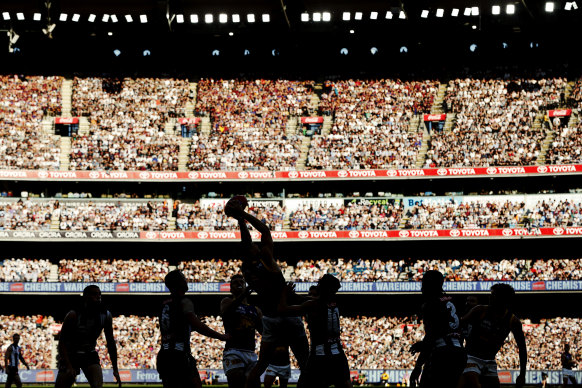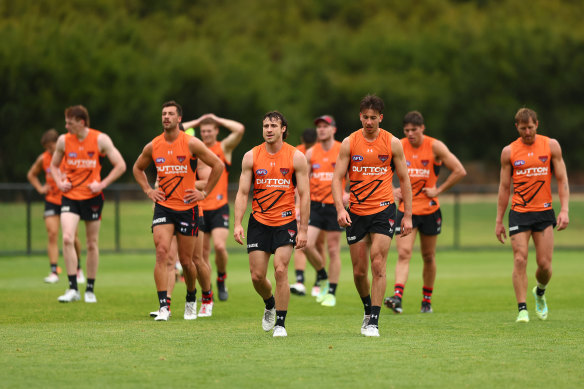By Peter Ryan
To the AFL, it is the latest step in the approach to address disordered eating in their sport and build the capacity of those dealing with players to understand the issues they might confront.
To the critics, it is a laughable call that only reinforces the perception that professional AFL players are being mollycoddled in a way that avoids public scrutiny while enjoying a lucrative career.

Disordered eating is often hiding in plain sight in elite sport.Credit: Paul Rovere
It is the directive from the AFL not to publish the weights of male players in the AFL season guide – a tome lovingly referred to as the footy bible – for the first time. And they won’t be in the AFL Record either, a publication that has carried the heights and weights of players in its grand final edition since 1917.
The decision, which only came to light when the book came off the press earlier than usual last Friday, was arrived at in August by a working group with a focus on disordered eating. That working group was set up within the AFL’s mental health and wellbeing unit early last year and deals with issues that don’t get spoken about much such as physique assessment.
It was another step towards “de-emphasising body weight” that the AFL has been taking lately, in line with a position statement the Australian Institute of Sport put out in 2020 called “disordered eating in high-performance sport”.
No weight measures have been published for AFLW players and the use of skinfold tests for all AFL draft prospects has been banned. The lists of players representing their states in the under-18 championships published on the AFL website only carried the players’ heights.
“For us, we need to adopt some of those core principles that the AIS have led with and make them very nuanced for our industry. What that looks like is drawing on the expertise of our working party,” the AFL’s head of mental health and wellbeing Kate Hall said in March.

AFL players come in all shapes and sizesCredit: Getty Images
If you think it is an initiative driven by the players, you are wrong. The AFL Players’ Association supports this latest decision but was not aware it was happening. Nor had the union put forward any argument that it should happen, according to a spokesperson.
Clubs were also not aware it was going to happen; there was no direct communication to club administrators that weights, which the publisher receives via a file that Champion Data supplies, were being left on the cutting room floor.
An AFL spokesperson said, “the policy update was done in consultation with experts and in step with the Australian Institute of Sport and international guidance on health and wellbeing”. But the reaction showed the decision wasn’t communicated in a way that might have brought people in and outside the game along the journey of what is an important discussion.
North Melbourne’s Charlie Comben went as far as to describe the decision as “totally bizarre” on X, formerly known as Twitter.
Those working at the coalface of disordered eating, such as the head of prevention at the Butterfly Foundation, Danni Rowlands, said it was a positive step towards addressing the stigma that surrounds disordered eating where many athletes grappling with the issue are, in Rowlands’ words, “hiding in plain sight”.
The Butterfly Foundation wasn’t involved in this decision and is not part of the AFL working group, but knows the seriousness of the issue, particularly among young people, and athletes are at higher risk than most of the population.
Rowlands knows sport – she played state level netball for many years and worked in the fitness industry before joining the Butterfly Foundation – and understands that without people being educated along the way, it’s hard for them to get why removing the weights from publication might be a good idea.
“What [the AFL] are acknowledging is actually that the weight of these athletes is the least important statistic about them,” Rowlands said. It could be argued, she told this masthead, that publishing a player’s 20-metre sprint time could be just as relevant and that players weren’t being stopped from sharing their weight – which often fluctuates – if they chose to do so.
Rowlands said there was still stigma attached to such discussions, particularly among male athletes, with few understanding the dire impact of disordered eating or how limiting eating issues can be for athletes.
“Research is limited, particularly in Australia, particularly with male athletes around this topic. We don’t have a true picture of what men are actually experiencing,” Rowlands said.
Richmond dietitian, Deakin’s Dr Dominique Condo, is preparing to do research to find out more, and the AFL is one sporting body recognising the discussion around what an athlete needs to perform needs to more scientific than just focusing on weight.
But the lack of discussion that occurred around the topic and the different sources reporting player weights, including club websites, meant the decision not to publish weights in the season guide was quickly placed in the “world’s gone mad” category.
For instance, last year’s No.1 draft pick Harley Reid, who seems destined to never have his weight printed in the season guide, weighs 78 kilograms and 87 kilograms, depending on which section of the West Coast website you read. He weighs 85 kilograms on other draft-related websites. He’s certainly carrying a heavier weight of expectation than any other player selected in last year’s national draft.
“That’s sport,” Rowlands said. “At the end of the day, surely it is about making sure these athletes are thriving in their sport.”
Keep up to date with the best AFL coverage in the country. Sign up for the Real Footy newsletter.
correction
An earlier version of this story incorrectly stated that AFL Records had listed weights since 1933.